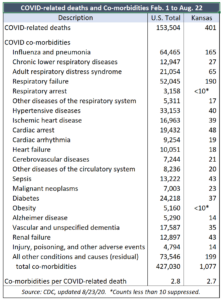The vast majority of deaths reported due to coronavirus involved patients with multiple underlying conditions, or comorbidities, the CDC reported on late last week. According to the report, 94% of reported coronavirus deaths were to patients with one or more comorbidities like diabetes and heart disease. COVID was the sole cause of death in only 6% of reported coronavirus-related fatalities.
 The CDC report says, “For deaths with conditions or causes in addition to COVID-19, on average, there were 2.6 additional conditions or causes per death.” The data in the CDC report was updated on August 26.
The CDC report says, “For deaths with conditions or causes in addition to COVID-19, on average, there were 2.6 additional conditions or causes per death.” The data in the CDC report was updated on August 26.
The spreadsheet linked to the report was updated through August 23, which shows an average of 2.8 comorbidities for the United States and an average 2.7 for Kansas.
The most frequent comorbidity listed for the nation and Kansas is “all other conditions and causes,” followed by “influenza and pneumonia.”
The Kansas Department of Health and Environment and the Johnson County Department of Health and Environment have not yet responded to requests to determine whether Kansas and its most populous county are tracking comorbidities and using that data to inform decisions on things like mask mandates and school reopenings.
Johnson County Commissioner Mike Brown says the current guidelines and recommendations from the state and county health departments are “agenda-driven.”
“It never ceases to amaze me how people with an agenda will use words like ‘follow the science’ and ‘use the data’ until it’s not convenient to them. And then with a straight face, they will blast down the road with a double standard,” he said.
For instance, the county health department regularly links to and uses CDC recommendations to inform its guidelines and the public. However, county health officials are ignoring a recent CDC recommendation to limit COVID testing to those who are showing symptoms of the illness.
JCDHE will continue to test asymptomatic individuals for COVID, despite the new CDC guidelines.
“Current evidence of COVID-19 indicates that asymptomatic individuals can spread COVID-19,” Dr. Sammi Areola, Director of JCDHE, said in an email. “JCDHE will continue to test asymptomatic individuals.”
Who is being tested and the number of tests being performed matters because the KDHE and JCDHE are using positivity rates to make policy recommendations, and in some cases, force mandates on citizens and employers. Most school districts, at the recommendation of KDHE statewide and JCDHE locally, are using only one data point to determine whether schools are open for in-person learning.
The Blue Valley School District, for example, is using gating criteria crafted by the JCDHE to decide when and if to allow in-person education for students. The department recommends that the county have 14 days with fewer than 5 percent of those testing receiving a positive test and a steady decrease in new cases. But critics warn without testing asymptomatic individuals, the gating data is skewed. Parents told the school board they want schools open for in-person instruction; they also held a rally to encourage the board to allow sports and other activities.
The county’s COVID data website does not report what percentage of individuals tested show symptoms at the time of testing. However, the Kansas Department of Health and Environment’s COVID reporting site does list the percentage of Kansas asymptomatic cases. As of Aug. 31, the state reports that 8 percent of Kansas’s 42,615 cases are reported as without symptoms, while 53.5 percent showed symptoms. In the remaining 38.4 percent of cases, whether the individual showed symptoms is unknown.
The Johnson County Health Department continues to re-examine the criteria it is using to guide how, when, and whether Johnson County schools reopen, according to Areola.
“We are always reviewing data related to schools,” he said. “I also want our schools to reopen.”
Though not a formal action item on tomorrow’s agenda, Johnson County Commissioner Mike Brown said the topic is likely to be revisited during the Johnson County Commission meeting Thursday.
Brown believes the gating criteria should include more than positivity rates, regardless of whether health officials are following CDC testing recommendations.
“The way the gating criteria is structured currently from JCDHE it only utilizes one statistic, and that is positive tests,” he said. “The fact is something as important as gating criteria should utilize all available data sets including hospitalization, ICU usage, and ventilator usage. Those things should all be factored in, too.”




